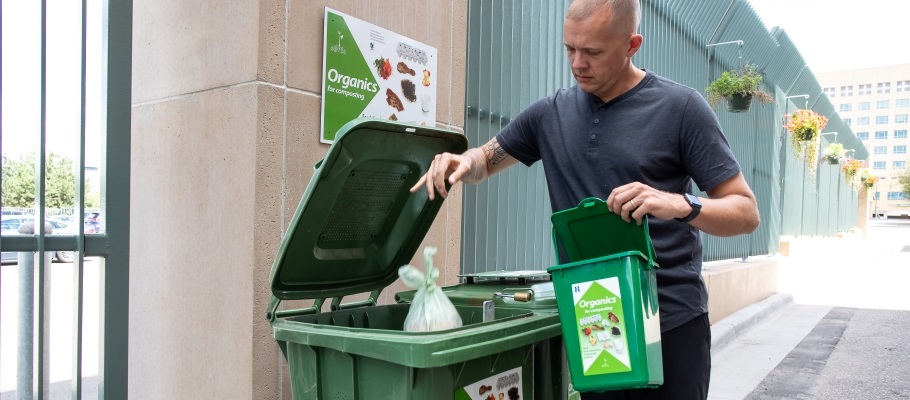Imagine all the organic waste we create with a meal: plate scrapings, fruit peels, vegetable odds and ends. Some people toss these in the trash without a second thought, though many more are starting to realize their value. Not only does it help the climate to remove food scraps from the trash, but finished compost benefits our lawns and gardens.

Get food scraps out of the garbage
Food scraps make up almost 25% of the trash in Hennepin County. When food scraps decompose in a landfill, they create methane, a potent greenhouse gas. When we choose to separate and compost that food instead, it reduces methane generation.
Composting involves collecting food scraps and non-recyclable paper to be turned into compost in a bin in your yard or at a commercial site. When you add compost to soil, it reduces the need for fertilizers and water, and reduces runoff and erosion, helping plants thrive. Giving your scraps new life is as easy as 1, 2, 3!

Step one: Throw those food scraps in a separate container in your kitchen
Don’t let leftover edible food go to waste! Make sure they’re true scraps. No amount is too little to save when your hard-earned money and resources are on the line. If you find your kitchen bin is filled with food that you could have eaten before it spoiled, prevent that waste in the future.
For the food that isn’t edible, any container will make a good collection bin: an old ice cream bucket, coffee can, plastic food storage container or simply a bowl can hold your scraps.
What you put in your collection bin depends on where the scraps will ultimately go. Backyard composting systems can take most fruit and veggie scraps, eggshells and bread, rice, or other grains. Curbside and drop-off organics programs allow all food, including meat, dairy, and bones, as well as certified compostable foodservice products such as takeout containers. If you participate in an organics program, your scraps should be collected in a certified compostable bag or paper bag that you can use to line your kitchen collection bin.

Step two: Bring those scraps to your curbside bin, a commercial compost site, or a backyard composting bin
Some people choose to do their composting at home, while others use a curbside or drop-off program where the material is taken to a local commercial compost facility. What you do depends on your access to organics recycling service and your personal preferences.
For curbside service it works like regular waste hauling. All you do is put your bagged food scraps into your cart and your hauler will pick it up and bring it to a commercial composting facility where it will be composted. Organics recycling drop-offs can be a good option for residents who don’t have organics recycling service available to them. That includes those who live in cities where it isn’t offered and those who live in apartment buildings, condos and townhomes that don’t have access to their city’s residential service.
If you have space in your backyard and like gardening, one tip is to compost at home. It does require a bit more maintenance than a curbside or drop-off program but results in free compost. First you need to build or buy a compost bin to hold the material. Then layer your food scraps and other organic materials with brown materials, such as dry leaves, in your compost bin. Maintain your compost pile by turning it with a shovel or pitchfork weekly or monthly. In six months to a year, the materials are recycled into compost.

Step three: The composted material lives again!
Compost is a nutrient rich material that builds soil and benefits plants. You can use it to feed your lawn, flowers, or herbs and veggies. Use it to grow more food and start the cycle over again! You can harvest the finished compost from your backyard pile or purchase it from commercial compost sites. Commercial compost is also used by landscaping companies and by the Department of Transportation to rebuild roadsides after construction. At home you can use compost to top dress your lawn, or garden with compost by mixing it into the soil before planting or using it as mulch by placing it 2-3 inches deep around existing plants to suppress weeds.

Tips and tricks for turning your food scraps into compost
In the kitchen
- Using no lid or a vented lid on your kitchen bin will help prevent bad smells. The bacteria that make decomposition stinky like low-air environments.
- Store wet food scraps in your fridge or freezer until you take them outside to slow down decomposition and prevent pests.
- Empty and wash your kitchen compost bin regularly.
Take care of your bins
- To keep your organics cart clean, don’t put food waste in it until the day before your pickup. If you already have smells or bugs in your cart, rinse it out with a hose.
- A backyard compost pile that isn’t breaking down may be too dry. Add more wet food waste, fresh plant material such as grass clippings, or water it! It should have the moisture of a wrung-out sponge.
Visit the Hennepin County resources for backyard composting and organics recycling for more tips and tricks as well as information on where curbside organics recycling service is available and how to sign up. Don’t let your food scraps go to waste another day when they can be recycled and live another life as compost.
